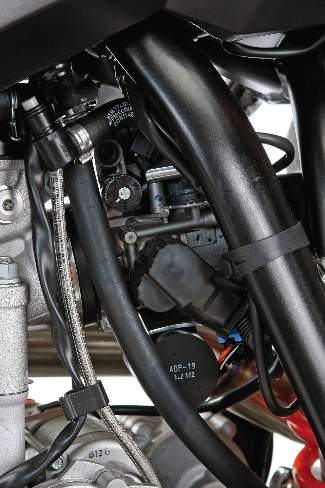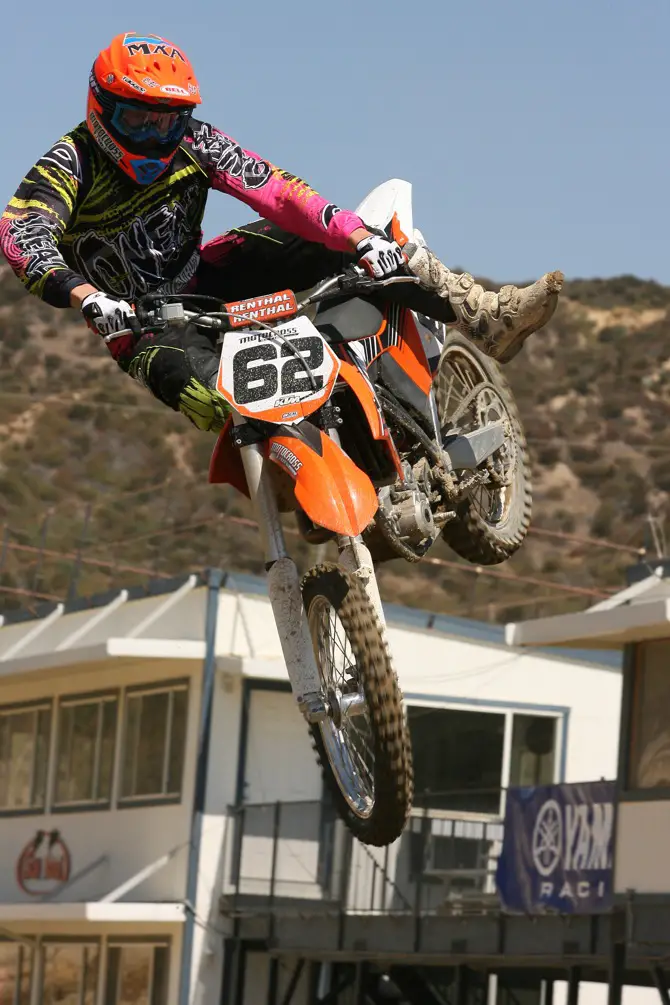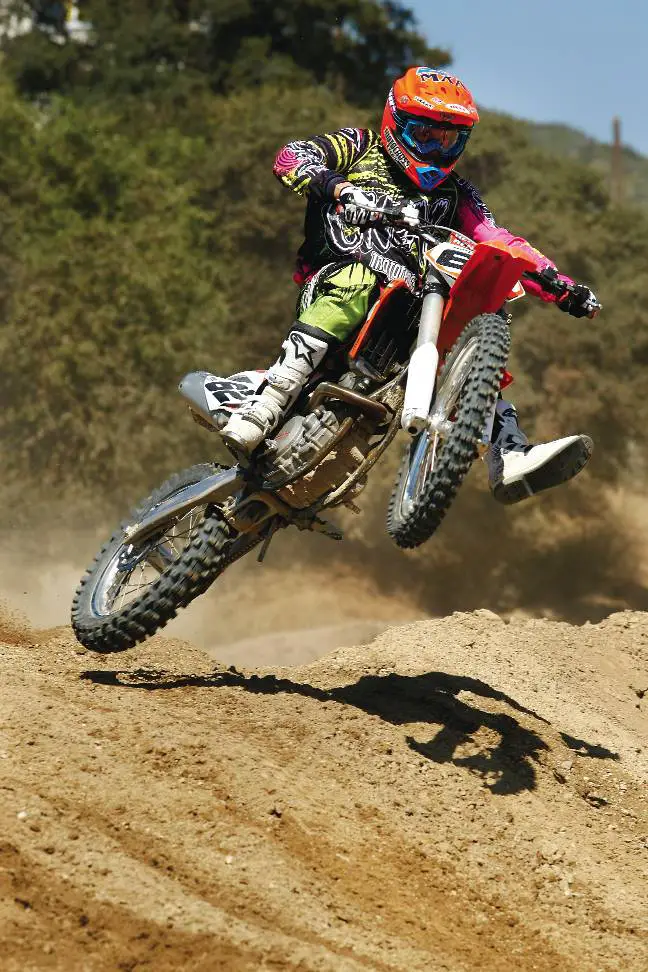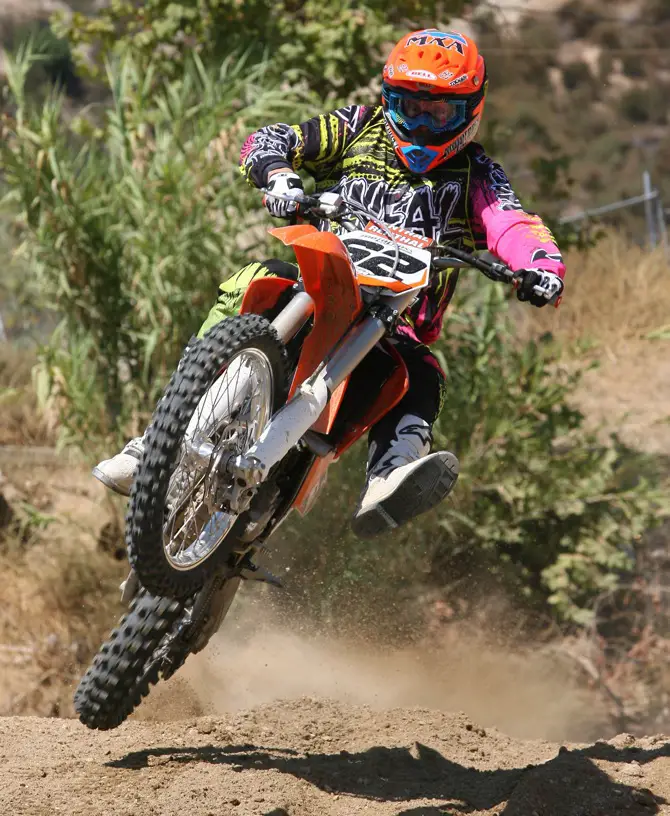MXA’S 2012 KTM 350SXF MOTOCROSS TEST: HAS THE 350 EXPERIMENT BEEN A SUCCESS? FIND OUT HERE

Q: FIRST AND FOREMOST, IS THE 2012 KTM 350SXF BETTER THAN THE 2011 350SXF?
A: Yes. Most MXA test riders took a quick glance at the 2012 spec sheet and thought that it was the same-old, same-old. Not true. After their first race, every test rider felt that the 2012 KTM 350SXF was significantly better than the 2011 model.
Q: IT IS CONTROVERSIAL, BUT IS THE 350SXF A SUCCESS?
A: You bet. Regardless of what the keyboard commandos say, the American public has embraced KTM’s 350cc, mid-sized engine philosophy. The 2011 KTM 350SXF was KTM’s biggest-selling bike of the year. How big? The sales numbers rivaled the heyday of 125 two-strokes, eclipsed 2011 250SXF sales and shattered KTM 450SXF numbers by four times.

2012 KTM 350SXF: Although controversial, the KTM?350SXF is a sales success. It is KTM’s largest selling model (and KTM sells more offroad bikes than any other brand).
Q: WHO BOUGHT THE FIRST-GENERATION 2011 KTM 350SXF?
 Focus: The 2011 KTM?350SXF engine’s peak horsepower was above 12,000 rpm. The 2012 model has the same peak number, but is much improved in the meat of the powerband. |
A: There were three main buyers for the 2011 KTM 350SXF:
(1) Goldilocks buyers: “Goldilocks buyers” are riders who think that 450cc four-strokes are too powerful, but 250cc four-strokes are not powerful enough. They bought the 2011 KTM 350SXF because it was “just right.”
(2) Vet riders: Vet riders aren’t bound by displacement rules and can race whatever they want. Many of them are old-school two-stroke riders who feel that the power output of a mid-sized four-stroke suits their style better than the grunt of a 450.
(3) Play riders: KTM is the master of the niche market. They make 125cc, 150cc, 200cc, 250cc, 300cc, 350cc, 450cc and 500cc offroad bikes to catch the eyes of the consumers. The KTM 350SXF obviously filled a gap that the Japanese brands weren’t servicing. It is, in many ways, the perfect play bike because of its electric starting and middle-of-the-road power output.
Q: HOW DOES THE 2012 KTM 350SXF DIFFER FROM THE 2011 350SXF?
A: Even in normal economic climates, second-year bikes don’t typically receive much in the way of updates?after all, it was brand, spanking new just 12 months ago. And in these hard economic times, the MXA test crew was surprised by how many changes KTM did make?even if they aren’t all readily visible to the untrained eye.
(1) Mapping. For 2011, KTM’s engineers thought it best to set the fuel and ignition mapping to the rich side of the scale. This cost some power, but it was a hedge against catastrophe. For 2012, the engineers rectified their fail-safe mapping with 3-percent leaner settings from low-to-mid and 2-percent leaner settings from mid-to-top. Of course, the ignition timing has also been advanced (approximately 2 degrees).
(2) Air boot. The air boot was all new last year, but it is all new this year also. Last year, the MXA wrecking crew pulsed the wire backfire screen out of our air boot’s velocity tube. That shouldn’t happen with the 2012, because the air boot is designed to keep it farther away from the suction force of the throttle body. Additionally, the velocity stack volume has been decreased, while the air-boot volume has been increased.
(3) Wiring harness. KTM believes that the problems it had last year, both with the ignition and Throttle Position Sensor (TPS), were water related. To solve these problems, they wrapped the 2012 wiring harness in a “marine-grade” sheathing and put a rubber bootie over the TPS sensor.
(4) Rear master cylinder. It was possible in previous years to over-stress the rear-brake master cylinder to the extent that the piston’s upper O-ring could snag in the master-cylinder orifice. No more! KTM had Brembo move the orifice to a central position between the two piston O-rings.
(5) Rear fender. Last year, the KTM rear fender flapped at mud races. For 2012, KTM reinforced the fender with a thick bead around its edge. Additionally, the side number plates and back portion of the airbox are now white plastic instead of black.
(6) Shock. With slightly softer low-speed damping and stiffer high-speed damping, the biggest change to the 350SXF shock is the step up from a 5.4 kg/mm shock spring to a more usable 5.7 kg/mm spring.
(7) Forks. The fork springs stay the same for 2012 (0.48 kg/mm), but are enhanced by more low-speed damping (to lessen diving) and new SKF fork seals (to increase durability).
(8) Tires. Gone is the Bridgestone M59/M70 combo of the past. In its place are Dunlop MX51 tires (front and rear). Even though the old Bridggies were discontinued tires that KTM somehow managed to get Bridgestone to build especially for them, they were a well-balanced set of sneakers. The Dunlop MX51 rear is a workmanlike tire, but the front MX51 is a little loose.
(9) Inline filter. Unlike the majority of fuel-injected bikes, KTMs come with quick-release fuel lines. This is a great feature, but does expose the fuel lines to potential contamination (simply because the fuel lines can be removed). To mitigate this danger, KTM has installed wire-mesh cone filters in the fuel lines just above the quick release to help catch debris.
 Fuel injection: The 350SXF not only gets leaner mapping, but the TPS sensor gets a rubber cover to protect it from water.
|
Q: IS THE 2012 350SXF FASTER THAN THE 2011 350SXF?
A: Yes. It is not only faster, but the powerband is much more usable than it was last year. We attribute the improved power to the new mapping and air boot, but would be remiss if we didn’t mention that it is rare for an engine to get so much better without a new exhaust, compression ratio or camshafts. To us, that means that the 2011 KTM 350SXF engine was definitely detuned on the production line. It also means that with a new map, a 2011 350SXF could be made to run as well as a 2012 model.
Q: HOW GOOD IS THE 2012 KTM 350SXF’S POWERBAND?
A: Plain and simple, the MXA test riders didn’t like the 2011 KTM 350SXF powerband. It was confused, drawn out, top-end focused and poorly mated to the KTM gearbox. It took forever to get to its peak horsepower, and that was at an amazingly high 12,200 rpm. We don’t know about your riding style, but we don’t have time to wait for a 350cc engine to lollygag its way up to the upper reaches of the rpm curve. Plus, if you shifted the 2011 KTM 350SXF before peak, you were riding a fairly slow, albeit pleasant, trail bike.
As much as we didn’t like the 2011 KTM 350SXF powerband, we like the 2012 version. KTM brought the meat of the powerband down into the working part of the curve. What an improvement! Now when the bike hits the midrange, it gets up and goes. Throttle response is improved, and the midrange has sufficient hit to help bridge last year’s sluggish transition. Good work!
Q: HOW DOES THE 2012 KTM 350SXF RUN ON THE DYNO?
A: Compare the number for yourself. The 2011 KTM 350SXF made 44.91 horsepower at 9000 rpm?the 2012 model makes 46.94 horsepower. The 2011 350SXF made 45.46 horsepower at 10,000 rpm?the 2012 model makes 47.63. The 2011 KTM 350SXF made 45.84 horsepower at 11,000 rpm?the 2012 model makes 46.99 horsepower. Peak horsepower is still at a rather high 12,200 rpm, but the 2012 KTM 350SXF is up 1.65 horses on top.
With a solid two horsepower gain, from 9000 rpm to 12,000 rpm, the 2012 KTM 350SXF is quicker, snappier, faster and more responsive.
Q: IS THE 2012 350SXF FASTER THAN THE 2012 450SXF?
A: Of course not. The 450SXF makes 10 more horses than the 350 through the meat of the powerband?and even at peak, the 450SXF is still pumping out 5 more ponies than the 350SXF. Assuming that you can handle that extra power, there is no way that “you on a 350SXF” will ever beat “you on a 450SXF.”
The trick is in getting the most out of the 450SXF. It’s not as easy as it sounds to tame a 54-horsepower machine. Big power often results in riders using less of it. In this case, it is much easier to get the most out of the 48.69-horsepower 350SXF. The formula is simple. If you race the 450SXF at full-tilt, it can’t be caught by the 350SXF; however, if you ride the 450SXF at 80 percent, then you’d be better off on the 350SXF.

Q: WHAT IS THE MUST-DO 2012 KTM 350SXF MOD?
A: Gear it down one tooth on the rear (from a 50-tooth sprocket to a 51-tooth sprocket). That extra tooth livens up the 350SXF’s throttle response, gets it to third gear faster and amps up the drive out of corners.
Q: WHAT DOES THE 2011 KTM 350SXF REALLY WEIGH?
A: There is a fly in KTM’s mid-sized ointment. The inherent design philosophy of building a mid-sized 350cc engine is that you can put it in a 250 frame and compensate for the loss of horsepower with a lower overall weight. This is a basic tenet of the power-to-weight ratio of performance engineering, and it is where KTM’s engineers lost their way.
The 2012 KTM 350SXF hit MXA’s scales at 236 pounds. For argument’s sake, that is 7 pounds lighter than a 2012 KTM 450SXF. It is, however, 5 pounds heavier than a 2012 Honda CRF450 and at least 10 pounds heavier than it needs to be to make the most of the power-to-weight ratio.

Q: WHERE CAN THE KTM 350SXF LOSE SOME OF ITS EXCESS WEIGHT?
A: The heavier-than-expected weight of the 350SXF comes from the EFI, electric starter and battery. Those are factory installed and destined to stay put, which means that you have to be creative to lose weight. Here is MXA‘s list:
(1) Battery. The stock Yuasa battery weighs 3-1/2 pounds. MXA changes out the stocker for a 1-pound Super B, Full Spectrum or Shorai iron-phosphate battery. That saves 2-1/2 pounds.
(2) Inner tubes. Tubes and tires vary in weight by as much as one pound apiece. Swapping out the stock Dunlop tubes for lighter Pirelli tubes could save another pound (at some increased risk of pinch flats).
 Choices: KTM triple clamps offer four-way adjustable fore-and-aft positions. They sell three optional bar heights. |
(3) Exhaust system. We want to drop-kick the stock KTM exhaust system as far as possible. Why? Because of its one-piece design, you can’t take the pipe off without removing the shock. And, you can’t take the shock off without removing the pipe. To solve this problem, we cut the stock pipe in half and had custom-made slip-fits welded on so that the pipe could be taken apart instead of the bike. But, a simpler solution is an aftermarket exhaust system. A full Ti exhaust system can save over two pounds versus the stocker.
(4) Weight savings. Apart from the battery, tires and pipe, there is not much potential to trim any additional excess fat without spending big bucks for small gains (as with titanium bolts). In the end, our three mods knocked six pounds off, bringing the weight, with an empty gas tank, down to 230 pounds.
Q: WHAT WAS OUR BEST FORK SETTING?
A: For hardcore racing, we recommend this fork setup on the 2012 KTM 350SXF:
Spring rate: 0.48 kg/mm
Oil height: 375cc
Compression: 15 clicks out
Rebound: 15 clicks out
Fork leg height: 5mm up
Notes: If you think the forks dive too much, which most MXA test riders do, you can raise the fork oil height by 10cc. Unless you are a bantamweight, we don’t think you will find the WP forks to be too stiff. KTM increased the compression damping slightly over 2011, but they could go firmer. The quickest way to firm up the middle of the stroke is with an aftermarket spring seat kit.
Q: WHAT WAS OUR BEST SHOCK SETTING?
A: For hardcore racing, we recommend this shock setup for the 2012 KTM 350SXF:
Spring rate: 5.7 kg/mm
Race sag: 105mm
Hi-compression: 2 turns out
Lo-compression: 15 clicks out
Rebound: 15 clicks out
Notes: We don’t think that the average 350SXF rider will need a stiffer shock spring (unless he is over 210 pounds). Smaller riders (those under 150 pounds) might opt to return to last year’s softer 5.4 kg/mm rear spring.
Q: HOW DOES THE 2012 KTM 350SXF HANDLE?
A: Handling is a touchy issue on modern race bikes, because they are all over the map. In the simplest terms possible, KTM has the best-handling bikes for the average racer. They turn accurately, don’t shake at speed, feel well balanced in the rough and have no irritating peccadilloes.
Some MXA test riders make the argument that Suzukis turn better than any bike made?and that is true. Suzukis are like scalpels in the tight stuff, but that prowess in the corners is courtesy of a very steep head angle, which makes the bikes very twitchy at speed.
The good news is that there is hope for the handling-handicapped CRF, KX-F and YZ-F, because KTM used to be the bottom feeder in the handling fish pond. With lots of work, KTM rose from the deep to become the big fish. We love the way the KTM 350SXF handles.

Energized: Thanks to a couple extra horses at 10,000 rpm, the 2012 KTM 350SXF is quicker, more responsive and easier to ride fast than it was last year.
Q: WHAT DID MXA DO TO MAKE THE KTM 350SXF WORK BETTER?
A: Here is the list:
(1) Reprogram. The KTM comes with three ignition maps already installed?you just have to access them. We remapped our ignition to run the 2011 “aggressive” map.
(2) Gearing. With last year’s lazy powerband, the gap between gears was too large. This year’s peppier powerband helps the tranny make the jumps easier to navigate?but not easy enough. Gearing it down one tooth helps the second-to-third shift and brings the rev limiter into sight.
(3) Gas cap. We cut off the tangs on the gas cap to disable the locking device. (If you do it just right, the gas cap will click off, but you won’t need two hands to open it).
(4) Oil filler cap. If you wear boots with hinges, they can hook on the black plastic oil-filler cap and unscrew it. You have three choices: (a) Clip the winglets off of the plastic cap. (b) Switch to an aluminum oil-filler cap. (c) Buy new boots.
(5) Handlebars. The stock Renthal 672 bars are too low. Most MXA test riders switched to the 12mm-taller Renthal 603 (Windham) Fatbars or 19mm-taller 604 Fatbars. The Windham and RC bars are available in TwinWalls also. For those who only want the bars a little higher, KTM offers 5mm-taller bar mounts (P/N 594-0103-9042) that, at $27.03, are cheaper than new bars.

Q: WHAT DID WE HATE?
A: The hate list:
(1) Shock preload ring. Hate it. Despise it. Who would make a preload ring out of rubber…well, something with the malleability of rubber anyway.
(2) Gearing. No sweat. With the exception of the KTM 250SX two-stroke, we gear every KTM down one or two teeth.
(3) Weight. No use crying over spilled milk, but from a theoretical point of view, this project could only work if the 350SXF were ten pounds lighter.
Q: WHAT DID WE LIKE?
A: The like list:
(1) Gas lines . We love the push-button quick releases on the gas tank and the extra fuel filters in the fuel lines.
(2) Fuel tank. At 1.98 gallons, the KTM 350SXF tank is a half-gallon larger than most other EFI gas tanks.
(3) Steel clutch basket. KTM has a lot of different clutch designs. The 350SXF has a steel clutch basket with an aluminum inner hub and pressure plate, but it is not the trick diaphragm clutch that comes on the 2012 KTM 450SXF or the all-aluminum Honda-style clutch that graces the 250SXF and two-strokes. It is, however, a very predictable and durable hydraulic clutch.
(4) Sound. On the FIM’s two-meter-max test, the KTM pumped out 114.3 dB, which is legal.
Q: WHAT DO WE REALLY THINK?
A: It’s not that the MXA wrecking crew had written off the 2011 KTM 350SXF as a failed race bike (albeit a sales success), but we weren’t enthralled by its undersprung suspension and lackadaisical powerband. Voila! KTM beefed up the spring rates and reconfigured the powerband for 2012. And that means that our opinion has changed. The 2012 KTM 350SXF is a very good race bike.





Comments are closed.